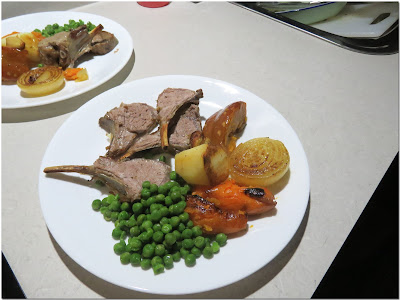We wanted to shop in Mt Isa but preferred not to stay in a caravan park, so we drove to the WWll Airfield Rest Area, 54 km NW of Mt Isa, for the evening. The site features eco-toilets, shelters, and barbecues. It's currently 4:10 pm, and we are surrounded by dark clouds with quite heavy drops of rain falling on the van. Hopefully, it will help cool down another very hot day, with the temperature at Camooweal when we left just after midday being 39 degrees.
The temperature has dropped considerably and is now quite pleasant at 28.5 °c inside the van.
We are waiting for the wind to ease so we can put up the awning and cook our meal outside on our BBQ, which eventually happened. We ate inside first, then sat outside with another glass of wine, admiring the incredible lightning off to the west.
It rained heavily on and off throughout the night, and we were awake several times, shutting and opening windows as the wind changed direction many times. It was cool enough during the evening to pull up the doona for extra warmth.
This morning was overcast with rain and a cool 21 °c, which makes for a lovely change.
We shared this large campsite with another van and several Wizz Bang vans.
With more consistent and heavier rain falling at 9 am, we decided to move into the Isa. Just under an hour later, we were looking for a place to park the van near one of the alcohol outlets, but that wasn't to be. Undeterred, I still managed to carry the carton of Fat Yak across the main highway and several hundred metres to where the van was parked in a side street. Then it was on to Coles and the dump point next to the racecourse.
A word of warning...all supermarkets are closed on Sundays in the Isa.
Our original plan was to continue on to Julia Creek for a few days, but with the free camp surrounded by black soil, we changed our minds.
With light rain still falling, we decided to head for Mary Kathleen, where we camped in early September. The access road into the old township was a bit boggy in places, and we camped on one of the old bitumen streets.
We left early today for a long drive that would take us through Cloncurry, before stopping in McKinlay for a coffee. We passed through here on our way to Darwin and stopped at the Walkabout Hotel, made famous by Paul Hogan in the first Crocodile Dundee film, to enjoy a brew.
This time, we took a detour down a side street to a local park and came across a plaque and statue honouring John McKinlay. He was born in Scotland in 1819 and died in Gawler, South Australia, in 1872.
Our original plan was to camp at Long Waterhole just south of Winton, but with the recent rains and the black soil, that was enough reason not to. We have often passed this rest area, so now was as good a time as any to stop here for the evening. We backed the van in as far as possible to get away from the highway, but we didn't need to bother because there was very little passing traffic during the night.
One of our days was spent travelling the 41 km into Barcaldine to do some shopping and sightseeing, but the rest of the time has been dedicated to relaxing. Ros has identified 27 bird species so far, and with one more day here, I'm sure the count will increase.
During our last two days, we assisted Jo and Bill, the caretaker, in moving sprinklers around the camping area after the lawns had been cut and trimmed. The estate agent, who is holding the auction, was bringing interested groups through for inspections.
We wish Jo all the best for the future.











































































